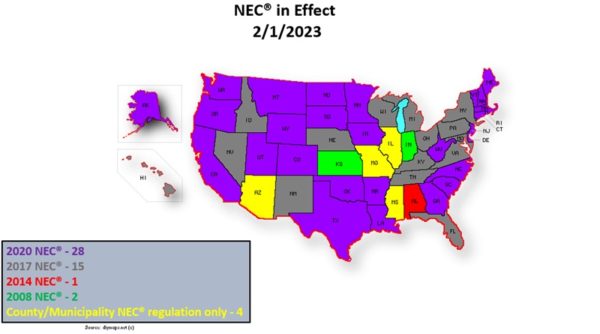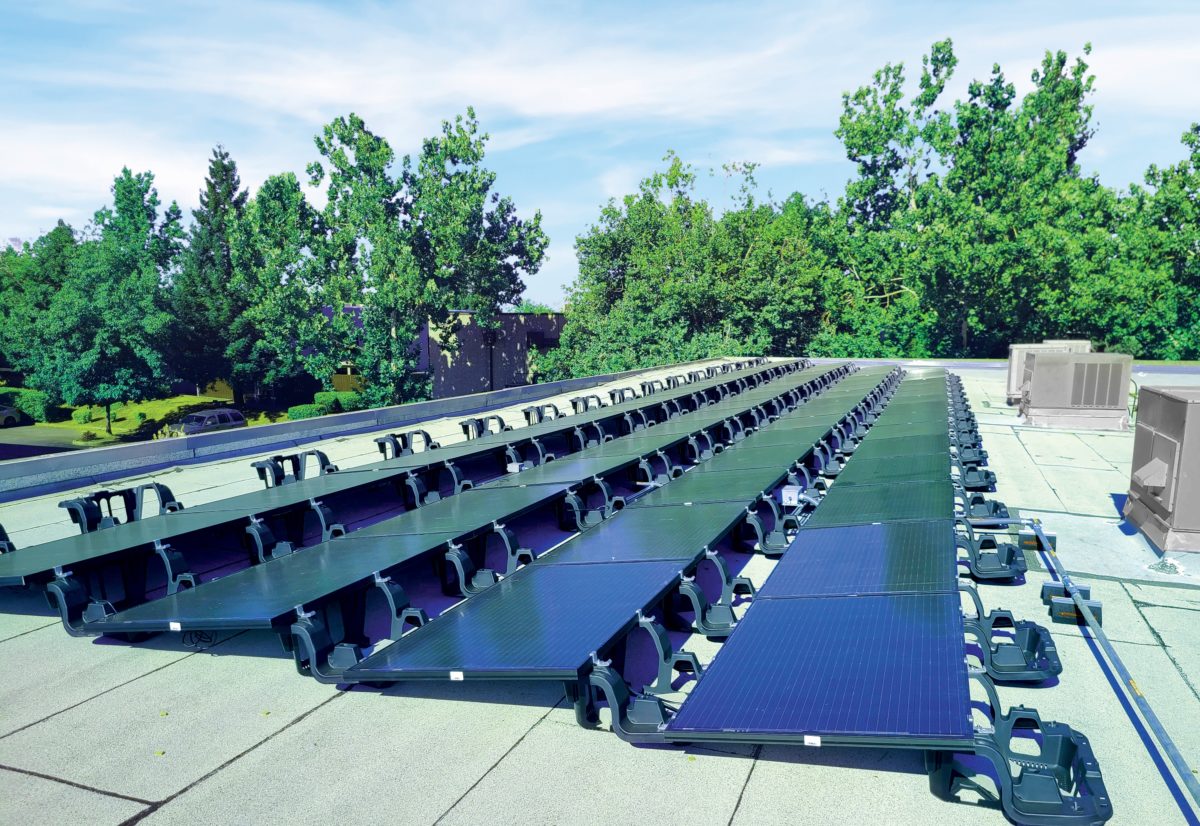In the first article of this series, the evolution of UL 1741 was outlined, including updates to IEEE 1547. It’s also relevant to understand the specific safety requirements regarding how PV circuits connect to inverters. These additional safety requirements are necessary to comply with the National Electrical Code (NEC). Three topics will be discussed in this article: PV direct current (DC) ground fault, PV DC arc fault and rapid shutdown.
The NEC, also known as NFPA 70, governs all electrical installations in the U.S. The National Fire Protection Association (NFPA) first published the code in 1897, which is now revised every three years. Conceptually, this code could be a uniform standard across the nation. In practice, individual states determine when to adopt any version of the NEC, creating a varied patchwork of regulation based on location.
The current adoption status is tracked by the NFPA – a regularly updated enforcement map of the U.S. can be found here.

This map illustrates that as of December 1, 2022, shortly after the publication of the 2023 edition of the NEC, only 25 states were enforcing the 2020 edition of the NEC, with all others enforcing an older edition. Article 690 in the NEC is focused on PV systems. This article first appeared in the 1984 edition of the NEC, 15 years before UL 1741 was published. The three topics of this article come from NEC article 690: PV DC ground faults are covered in NEC 2020 section 690.41(B), PV DC arc faults in 690.11, and rapid shutdown in section 690.12.
Ground fault detection
PV DC ground faults, in either positive or negative circuits, can happen for many reasons. Factors can include manufacturing defects, installation methods, rodents, project age combined with environmental stresses, and degradation of materials. Innovation in technology and materials has reduced these issues, but there is still risk. Reductions in the number of DC connections and improvements in wire management methods can further reduce ground fault occurrences.
PV DC ground fault detection is an important safety feature that indicates when either the positive or negative conductor unintentionally establishes a lower resistance (fault) path to ground. This can become a hazard because the fault can allow current flow through the fault path, often consisting of exposed conductive parts of the PV system. Originally, PV inverters were designed with transformers to boost converted alternating current (AC) voltage to the higher utility service levels. This transformer provided galvanic isolation of the DC side of the PV system from the AC conductors of the premises wiring system and its grounding electrode system. Because the PV array DC circuits were referenced to ground on the DC side of the inverter, the first ground fault detection was simply detecting current flow through the DC ground reference, such as by a fuse in the ground reference path.
The rapid adoption of transformer-less inverters coincided with concerns about fuse-based ground fault detection. Once the transformer was removed, the fuse-based method of ground fault detection was not possible since the PV array DC circuits could no longer reference the ground on the DC side of the inverter. To work with the transformer-less inverters, a two-part ground fault detection system was developed. This system verifies high resistance of both PV conductors to ground and monitors residual current for leakage.
The improved method more readily identified faults and changes that indicate PV system degradation. The updated detection method was incorporated into UL 1741 as a Certification Requirements Decision (CRD) for smaller non-isolated systems in 2010.
Key Take Away: Robust, sensitive ground fault protection tailored to transformer-less inverters is well established.
Series arc fault detection
Series PV DC arc faults can occur when a circuit conductor is broken, or a connection is opened while current is flowing. This has been a problem with DC connectors, such as when they are not securely mated. Other potential series arc sources include manufacturing defects, improper installation, environmental stresses, and pairing different manufacturer’s connectors, known as mismatching.
Arc fault detection for PV DC ground circuits operating at 80V DC or greater first appeared in the 2011 edition of the NEC. The original listing process for DC arc fault interrupters UL 1699B, was published as an outline of investigation in 2011, but did not become a full Edition 1 standard until 2018. The full standard updated testing methodology to improve the performance and reliability of devices successfully achieving this listing.
The arc fault requirements that were added in section 690.11 required detection and interruption of a series arc. Once detected, the series arc should be extinguished by stopping all current flow in that circuit. Opening a PV DC circuit connection is a function that is straightforward for an inverter to perform. It’s possible for the inverter to provide all the functionality required by code (detection and interruption) internally. This can also be achieved via external devices designed and certified for PV DC arc fault detection and interruption. Correct detection of an arc, while ruling out false positives generated by things like the opening of a DC disconnect, is not an easy task. SMA was the first inverter manufacturer to achieve listing to UL 1699B in 2012 and, along with other manufacturers in the industry, has updated and improved the performance of devices carrying out this critical safety feature in the decade since.
Key Take Away: Code has required arc fault protection for more than ten years, and UL testing standards have been updated to greatly improve the performance of listed devices.
Rapid shutdown
Starting in 2014, the NEC included section 690.12 for rapid shutdown of PV systems. The rapid shutdown requirement was designed to reduce the potential for firefighters working near a PV system to be shocked by energized wiring that may be concealed from them.
Originally, conductors outside a 10-foot boundary of a PV array, or penetrating a building of 5 feet or more, were required to reduce voltage (to 30V or less) and power within 10 (later 30) seconds of the initiation of rapid shutdown. Equipment performing this task only had to be listed, but not listed to a rapid shutdown standard.
The 2017 NEC greatly expanded section 690.12. The biggest modification was the addition of rapid shutdown requirements internal to the array boundary (reduced to one foot around the array). Three options for compliance are allowed, use of any one of which fully satisfies the requirement.
The first option was to have the array certified as a rapid shutdown PV array. This required a safety standard that had not been written. In the 2020 NEC, this first option was revised to require a certified PV hazard control system and an informational note referred to UL 3741 PV Hazard Control. This standard was published in December of 2020, almost four full years after this “option” for compliance was introduced into code.
The second option required conductors within the array boundary to be limited to 80V DC or less within 30 seconds. Compliance under this option required inserting module level electronics (MLE) underneath each module, such as DC/DC optimizers or microinverters. Unlike the first option, devices applicable to a PV system allowing compliance under this option were available at the publishing of the 2017 NEC, resulting in the de facto requirement of module level electronics to comply with 2017 NEC 690.12(B)(2).
The third option was added to consider building integrated PV (BIPV) or other systems that would not have any exposed wiring methods or conductive parts and be installed more than 8 feet from any grounded conductive parts.
Since the publication of UL 3741, there have been several manufacturers (system integrators and racking suppliers) that have obtained a UL 3741 certification. UL 3741 allows for different methods of PV hazard control and defines the evaluation required to determine acceptable risk levels of PV arrays using these methods.
Compliance with UL 3741 can be obtained by using specific levels of physical and or fault protection to remove the need for inserting any electronic devices in the DC string, or through the use of module level electronics or string voltage limiters.
Using protection methods (such as better wire routing and securing to keep wiring from faulting to frames or racking) without requiring the use of electronic devices has the added benefit of reducing ground fault risk and reducing the number of DC connectors. The concern of arcs caused from mismatched connectors resulted in the 2020 NEC adding in 690.33(C) the requirement that mating connectors either be identical type and brand or listed and identified for intermatability. Reducing the complexity of the PV system will increase the reliability, reduce injury risk and decrease likelihood of fire.
Key Take Away: Rapid shutdown requirements are not changing rapidly in the NEC. However, many more options for compliance are becoming commercially available with the publication of UL 3741.
There is a noticeable lag between when code requires changes and when testing and listing standards are established to ensure commercial devices can provide that safety feature. In the final article of this series, we will discuss an area of code that is newer and changing very rapidly – requirements for energy storage systems.
 Mike Mahon is a senior technical training specialist with the SMA Solar Academy, delivering in-person training and webinars covering all SMA America PV and battery string inverters, communications products and software platforms.
Mike Mahon is a senior technical training specialist with the SMA Solar Academy, delivering in-person training and webinars covering all SMA America PV and battery string inverters, communications products and software platforms.

Steve Wurmlinger is the Manager of US Norms and Standards at SMA with the responsibility of representing SMA on various industry discussions and direct involvement in developing requirements for: US codes, UL safety standards, IEEE technical standards and utility interconnection requirements for inverters, plant controllers and energy storage systems.
The views and opinions expressed in this article are the author’s own, and do not necessarily reflect those held by pv magazine.
This content is protected by copyright and may not be reused. If you want to cooperate with us and would like to reuse some of our content, please contact: editors@pv-magazine.com.








By submitting this form you agree to pv magazine using your data for the purposes of publishing your comment.
Your personal data will only be disclosed or otherwise transmitted to third parties for the purposes of spam filtering or if this is necessary for technical maintenance of the website. Any other transfer to third parties will not take place unless this is justified on the basis of applicable data protection regulations or if pv magazine is legally obliged to do so.
You may revoke this consent at any time with effect for the future, in which case your personal data will be deleted immediately. Otherwise, your data will be deleted if pv magazine has processed your request or the purpose of data storage is fulfilled.
Further information on data privacy can be found in our Data Protection Policy.